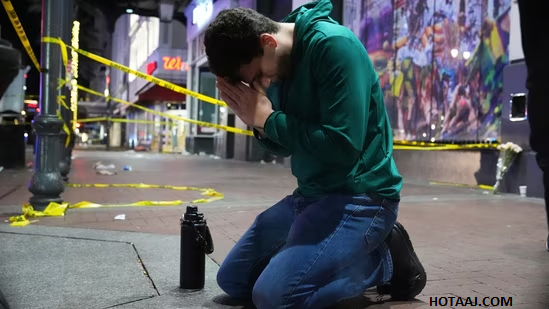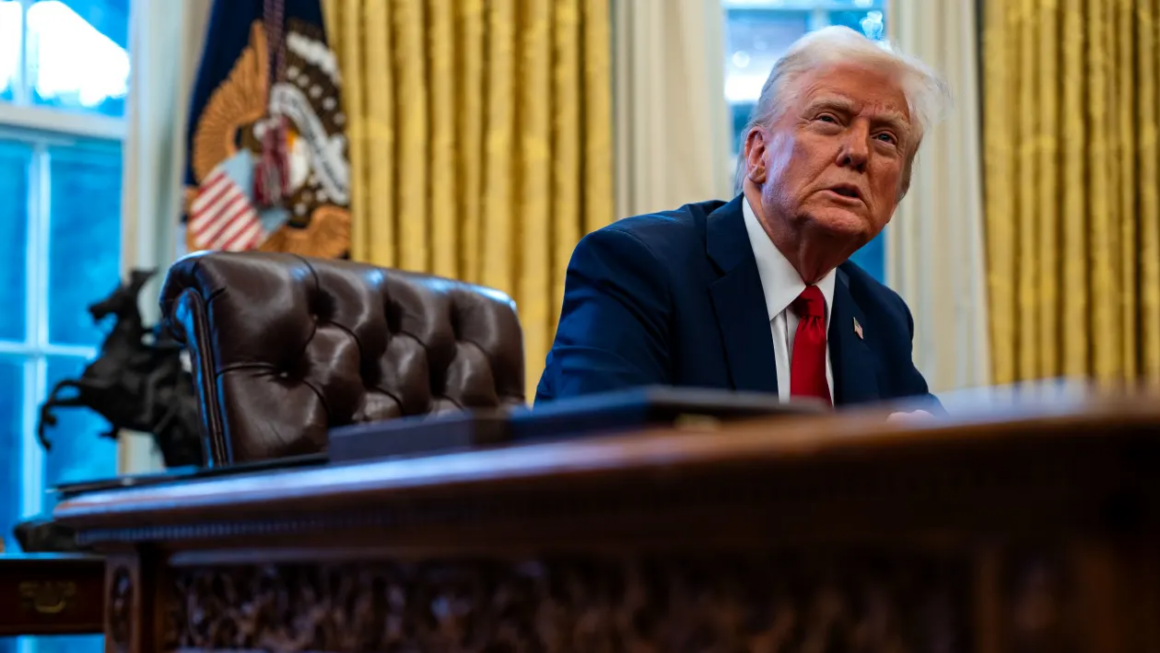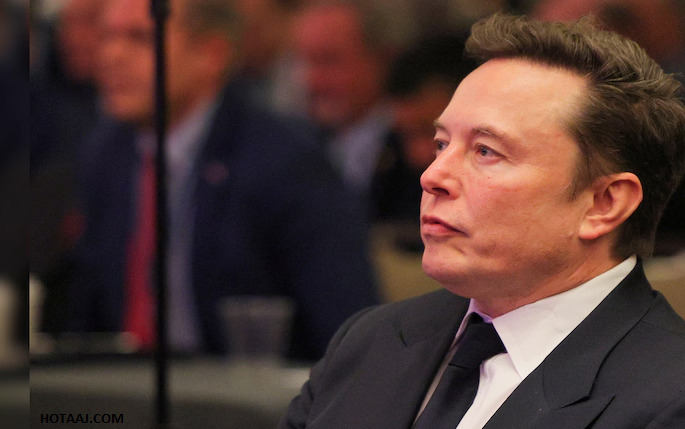Shamsud-Din Jabbar, who killed 14 by driving a truck into a Bourbon Street crowd, posted 5 Facebook videos hours before the attack.

According to a report by news agency Reuters, the New Orleans attacker, Shamsud-Din Jabbar, recorded a chilling video prior to the deadly incident, in which he revealed his earlier intention to harm his own family and friends. However, he claimed to have reconsidered his plan, expressing concern that the media coverage would not highlight what he described as the “war between the believers and the disbelievers.” The video surfaced during the ongoing investigation into the attack, where Jabbar drove a pickup truck into a crowd on Bourbon Street, killing 14 people. FBI Deputy Assistant Director Christopher Raia, who briefed the media, confirmed that the agency is carefully analyzing the suspect’s motives and possible extremist affiliations.
Jabbar also claimed in the videos that he had joined the Islamic State terrorist group (ISIS) before last summer and went on to share his last will and testament, according to FBI Deputy Assistant Director Christopher Raia. These revelations are part of the ongoing investigation into his motive and possible connections to extremist networks.
Shamsud-Din Jabbar, 42, who carried out a deadly attack by driving a pickup truck into a crowd on Bourbon Street, resulting in 15 fatalities and numerous injuries, posted five videos on Facebook just hours before the incident, FBI Deputy Assistant Director Christopher Raia revealed during a news briefing on Thursday.
Shamsud-Din Jabbar, a 42-year-old Texas-born U.S. citizen and Army veteran who served in Afghanistan, referenced his personal struggles, including his divorce, in the videos posted before the attack. According to CNN, citing two officials familiar with the recordings, Jabbar revealed that he initially planned to gather his family for a “celebration” with the sinister “intention of killing them.” This disturbing admission sheds light on his mental state and the possible factors contributing to the tragic incident on Bourbon Street.
According to CNN, FBI Deputy Assistant Director Christopher Raia stated that the videos, which Hindustan Times could not independently verify, were posted on Shamsud-Din Jabbar’s Facebook page between 1:29 a.m. and 3:02 a.m. on Wednesday, just hours before the fatal attack on Bourbon Street.
Who Was Shamsud-Din Jabbar?
Shamsud-Din Jabbar, a former U.S. Army member, was the perpetrator behind the tragic New Year’s Day attack on Bourbon Street. After driving a pickup truck into a crowd, killing 15 people and injuring many others, Jabbar engaged in a firefight with police, during which he opened fire and wounded two officers before being fatally shot.
Jabbar served in the U.S. Army from March 2007 to January 2015, followed by service in the Army Reserve from January 2015 to July 2020. During his military career, he was deployed to Afghanistan from February 2009 to January 2010. He ended his service with the rank of staff sergeant. His military background, combined with his post-service struggles, is now under scrutiny as investigators work to understand his radicalization and motives.
Abdur-Rahim Jabbar, the younger brother of Shamsud-Din Jabbar, expressed disbelief over his brother’s involvement in the horrific attack. Speaking to The Associated Press on Thursday, he said, “It doesn’t feel real. I never would have thought it’d be him. It’s completely unlike him.”
Abdur-Rahim noted that his brother had been increasingly isolated in recent years, but they had maintained some contact. He added that during their recent conversations, he hadn’t observed any indications of radicalization or extreme behavior. His remarks reflect the shock and confusion shared by those close to Jabbar, as investigators continue to piece together the factors that led to the deadly incident.
The FBI recovered a black Islamic State (ISIS) flag from Shamsud-Din Jabbar’s rented pickup truck, confirming his links to the militant group. Despite its territorial defeat following a U.S.-led military campaign, ISIS continues to recruit sympathizers online.
Before launching the attack, Jabbar planted two improvised explosive devices. Around 3:15 a.m. local time, he rammed his truck into a crowd of revellers on Bourbon Street. Following the crash, eyewitnesses reported that Jabbar, dressed in full body armour and armed with an assault rifle, exited the vehicle and exchanged gunfire with police before being fatally shot.
A U.S. government official, speaking on condition of anonymity, informed the Associated Press that Jabbar had visited Egypt in 2023, spending a week in Cairo before returning to the U.S. He then traveled to Toronto for three days. The purpose of these trips and his activities during that time remain under investigation.
Shamsud-Din Jabbar’s attack on Bourbon Street shocked both local and national authorities. The discovery of the ISIS flag in his truck and the planting of improvised explosive devices (IEDs) indicate that the attack may have been meticulously planned, with potential larger-scale intentions. The presence of body armor and an assault rifle further suggests that Jabbar was prepared for a violent confrontation.
Eyewitnesses recalled seeing Jabbar exit the vehicle after crashing into the crowd, wearing full-body armor and carrying a weapon, which raised concerns about his readiness to engage in a prolonged attack. His gunfight with the police further escalated the violence, ending only when he was fatally shot by law enforcement.
The investigation has expanded to examine Jabbar’s international movements. His trips to Egypt and Toronto in 2023 are of particular interest. While the details of his activities during these travels are unclear, the timing and nature of these trips have prompted authorities to explore potential connections with extremist networks or radical ideologies. These trips could also provide insight into any potential training or preparations he might have undertaken, which might explain his actions on New Year’s Day.
As the investigation unfolds, law enforcement agencies are working to understand Jabbar’s motivations, whether he was acting as an individual or as part of a broader network. The FBI and other authorities are continuing to analyze his communications, personal history, and travel patterns to uncover more about his radicalization and the planning that led to this tragic event.
COURTESY: CRUX
References
- ^ “Répertoire national des élus: les maires” (in French). data.gouv.fr, Plateforme ouverte des données publiques françaises. 6 June 2023.
- ^ “Populations légales 2021” (in French). The National Institute of Statistics and Economic Studies. 28 December 2023.
- ^ “Évolution et structure de la population en 2020 − Unité urbaine 2020 d’Orléans (45701)” (in French). INSEE. Retrieved 24 January 2024.
- ^ Jump up to:a b “Évolution et structure de la population en 2020 − Aire d’attraction des villes 2020 d’Orléans (025)” (in French). INSEE. Retrieved 24 January 2024.
- ^ Jump up to:a b “Orleans” (US) and “Orleans”. Lexico UK English Dictionary. Oxford University Press. Archived from the original on 22 March 2020.
- ^ Jump up to:a b “Orléans”. Collins English Dictionary. HarperCollins. Retrieved 12 April 2019.
- ^ “Orléans”. The American Heritage Dictionary of the English Language (5th ed.). HarperCollins. Retrieved 12 April 2019.
- ^ “Orléans”. Merriam-Webster.com Dictionary. Merriam-Webster. Retrieved 12 April 2019.
- ^ Jump up to:a b Population en historique depuis 1968, INSEE
- ^ “Évolution et structure de la population en 2020 − Intercommunalité-Métropole de Orléans Métropole (244500468)” (in French). INSEE. Retrieved 24 January 2024.
- ^ “Vérification – Il y aurait près de 20.000 étudiants à Orléans : Vrai ou faux ?”. 6 May 2021.
- ^ “Climatological Information for Besançon, France”. Meteo France. 14 February 2019. Archived from the original on 12 June 2018. Retrieved 30 December 2015.
- ^ “Orléans (45)” (PDF). Fiche Climatologique: Statistiques 1991–2020 et records (in French). Meteo France. Retrieved 14 February 2019.
- ^ “Normes et records 1961–1990: Orléans – altitude 123m” (in French). Infoclimat. Retrieved 14 February 2019.
- ^ “Orleans, emporium des Carnutes”. Archeologie Orleans Metropole.
- ^ “Les raffineries de sucre”. Archives Orleans Ville et Metropole.
- ^ “Le vinaigre et Orleans”. Archives Orleans Ville et Metropole.
- ^ “C. Julius Caesar, Gallic War, Book 7, chapter 28”. www.perseus.tufts.edu. Retrieved 16 February 2018.
- ^ Larousse, Éditions. “Orléans – LAROUSSE”. www.larousse.fr (in French). Retrieved 28 April 2021.
- ^ For an exact etymology, see Cenabum, Aurelianis, Orléans de Jacques Debal (Coll. Galliae civitates, Lyon, PUL, 1996)
- ^ marres.education Archived 20 May 2020 at the Wayback Machine. Accessed January 2016.
- ^ World-wide current events of 16 May 1941, available on the site of the INA (direct link).
- ^ Joseph Abram, L’architecture moderne en France, du chaos à la croissance, tome 2, éd. Picard, 1999, pp. 28 et 37–38
- ^ Grand Larousse encyclopédique in 10 volumes, 163
- ^ Des villages de Cassini aux communes d’aujourd’hui: Commune data sheet Orléans, EHESS (in French).
- ^ Rapport annuel 2022 Parc – trafic – événements d’exploitation Tramways, Service Technique des Remontées Mécaniques et des Transports Guidés, p. 8.
- ^ “L’école Marcel-Proust a découvert la vie de la mairie”. la République. 24 May 2019. Retrieved 28 October 2024.
- ^ “Tribunal administratif d’Orléans : Histoire du tribunal”. Archived from the original on 22 April 2014. Retrieved 3 November 2014.
- ^ “La Motte Sanguin – Orleans.fr”. Archived from the original on 16 April 2015. Retrieved 3 November 2014.
- ^ J. DEBAL, Orléans : Une Ville, Une Histoire
- ^ Les Français érigent une statue de Calvin Archived 6 July 2011 at the Wayback Machine, sur le site Bonnenouvelle.ch.
- ^ “CERCIL – Study and Research Centre on the Internment Camps in Loiret: Remembrance”. Information Portal to European Sites of Remembrance. Berlin, Germany: Stiftung Denkmal für die ermordeten Juden Europas. Retrieved 19 June 2020.
- ^ Patrice Gabin (13 October 2007). “Orléans tourisme : musées à Orléans (Orléans tourism: Museums in Orléans)”. Archived from the original on 13 October 2007. Retrieved 6 April 2011.
- ^ Patrice Gabin (13 October 2007). “Park and Gardens in Orléans”. Archived from the original on 13 October 2007. Retrieved 6 April 2011.
- ^ “Festivals de musique – France”, Identifiants et référentials, retrieved 6 May 2018
- ^ “Les villes amies”. orleans-metropole.fr (in French). Orléans. Retrieved 15 November 2019.













